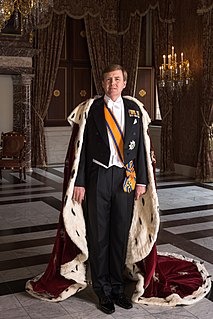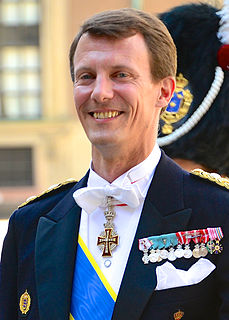
Willem-Alexander is the King of the Netherlands, having acceded to the throne following his mother's abdication in 2013.

The chinstrap penguin is a species of penguin that inhabits a variety of islands and shores in the Southern Pacific and the Antarctic Oceans. Its name stems from the narrow black band under its head, which makes it appear as if it were wearing a black helmet, making it easy to identify. Other common names include ringed penguin, bearded penguin, and stonecracker penguin, due to its loud, harsh call.

Prince Joachim of Denmark, Count of Monpezat, is a member of the Danish royal family. The younger son of Queen Margrethe II, he is sixth in the line of succession to the Danish throne, following his elder brother, Crown Prince Frederik, and Frederik's four children.

Prince Carl Philip of Sweden, Duke of Värmland, is the only son and the second of three children of King Carl XVI Gustaf and Queen Silvia. As of 2016, Prince Carl Philip is fourth in the line of succession, after his older sister, Crown Princess Victoria, his niece and goddaughter Princess Estelle, and his nephew Prince Oscar. He lives with his wife, Princess Sofia, and three sons, Prince Alexander, Prince Gabriel and Prince Julian in Villa Solbacken in Djurgården, Stockholm.

The following is a list of public holidays in Romania. According to Romanian law, Romania had 51 public holidays as of 2011, which cover 14% of the days of the year in the country.

The Hepialidae are a family of insects in the lepidopteran order. Moths of this family are often referred to as swift moths or ghost moths.

The brown skua, also known as the Antarctic skua, subantarctic skua, southern great skua, southern skua, or hākoakoa (Māori), is a large seabird that breeds in the subantarctic and Antarctic zones and moves further north when not breeding. Its taxonomy is highly complex and a matter of dispute, with some splitting it into two or three species: Falkland skua, Tristan skua, and subantarctic skua. To further confuse, it hybridizes with both the south polar and Chilean skuas, and the entire group has been considered to be a subspecies of the great skua, a species otherwise restricted to the Northern Hemisphere.
The Hepialoidea are the superfamily of "ghost moths" and "swift moths".
Antihepialus is a genus of moths of the family Hepialidae. There are four described species, found in southern and eastern Africa.

The gummy shark, also known as the Australian smooth hound, flake, sweet william or smooth dog-shark, is a shark in the family Triakidae. These small to medium-sized bottom-dwelling sharks are found mostly in, but are not limited to, the area around the southern seas of Australia and is commonly baited and fished for cuisine because of its taste and market prices. According to a 2021 paper by White, Arunrugstichai & Naylorn (2021), Mustelus walkeri is the same animal as M. antarcticus. One theory is that M. walkeri is a subpopulation of M. antarcticus.

Gracillariidae is an important family of insects in the order Lepidoptera and the principal family of leaf miners that includes several economic, horticultural or recently invasive pest species such as the horse-chestnut leaf miner, Cameraria ohridella.

Somniosus is a widely distributed genus of deepwater dogfish sharks in the family Somniosidae. Several members of the genus are believed to attain lengths up to 7 m (23 ft), thus ranking among the largest of sharks.

The southern sleeper shark or Whitley's sleeper shark is a deepwater benthopelagic sleeper shark of the family Somniosidae found in the southern Atlantic, Indian, and Pacific Oceans.

The insect order Lepidoptera consists of moths, most of which are night-flying, and a derived group, mainly day-flying, called butterflies. Within Lepidoptera as a whole, the groups listed below before Glossata contain a few basal families accounting for less than 200 species; the bulk of Lepidoptera are in the Glossata. Similarly, within the Glossata, there are a few basal groups listed first, with the bulk of species in the Heteroneura. Basal groups within Heteroneura cannot be defined with as much confidence, as there are still some disputes concerning the proper relations among these groups. At the family level, however, most groups are well defined, and the families are commonly used by hobbyists and scientists alike.
Antarctica is one of the most physically and chemically extreme terrestrial environments to be inhabited by lifeforms. The largest plants are mosses, and the largest animals that do not leave the continent are a few species of insects.
Antihepialus capeneri is a species of moth of the family Hepialidae. It is known from South Africa.
Antihepialus keniae is a species of moth of the family Hepialidae described by William Jacob Holland in 1892. It is known from Kenya, Tanzania and Uganda.
Antihepialus vansoni is a species of moth of the family Hepialidae. It is known from South Africa.
Cryomyces antarcticus is a fungus of uncertain placement in the class Dothideomycetes, division Ascomycota. Found in Antarctica, it was described as new to science in 2005. It has been found to be able to survive the harsh outer space environment and cosmic radiation. A proposed mechanistic contributor to the unique resilience observed in C. antarcticus is the presence of its thick and highly melanized cell walls. This melanin may act to protect DNA from damage while C. antarcticus is exposed to conditions that are unsuitable for typical DNA repair systems to function.
Prins Gunasekera was a Ceylonese politician, who represented the Habaraduwa electorate in the Galle district.











